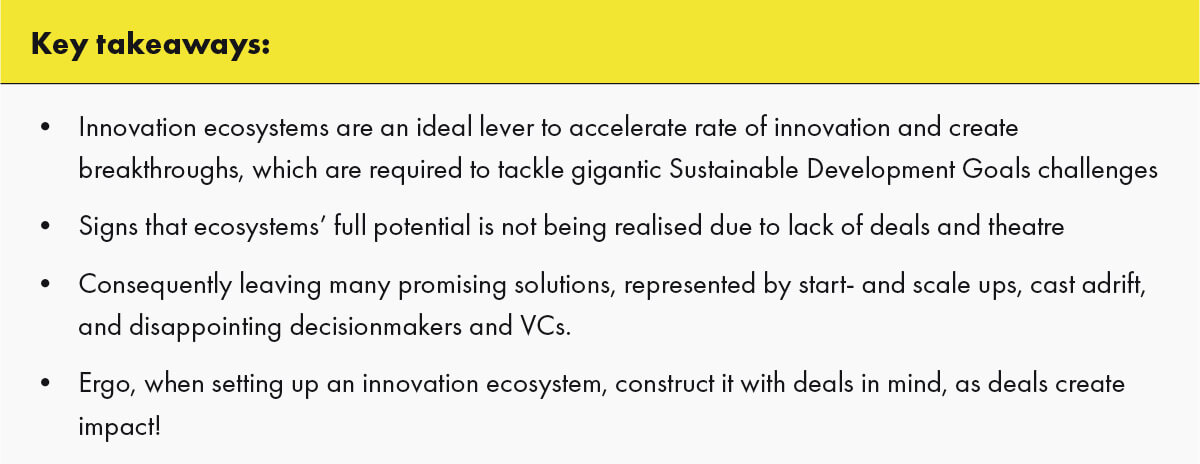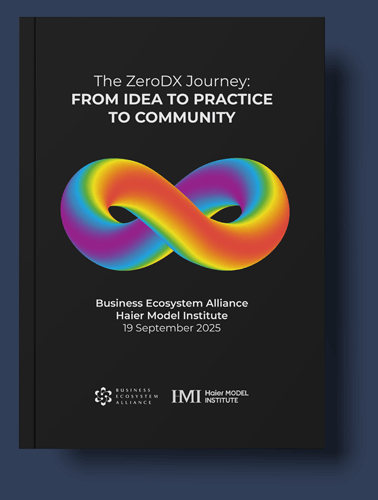Innovation ecosystems thrive by deals and perish by theatre
Ank van Wylick, Camal Handor and Steffie Op de Laak
Every respectable organization is attending, building, or orchestrating some kind of innovation ecosystem, in order to solve complex business challenges. Accelerating the rate of discovering innovative solutions is paramount. But we increasingly hear from innovators within frontrunning organizations that there is too much ecosystem theatre and not enough action or impact.
On one hand, we see that the need for acceleration in innovation has never been greater, considering the gigantic challenges represented in the UN’s Sustainable Development Goals. On the other hand, there are many solutions being provided by a range of companies, including start-ups and scale-ups, which are failing to find the right partner to help them grow.
That is why we at 42Collective are concerned that the benefits of innovation ecosystems will be at risk if theatre prevails. It is more important to focus on creating deals, as deals provide the energy and momentum needed to keep innovation ecosystems thriving, so they can achieve the desired acceleration of innovation.
Deals lead to accelerated rate of innovation
Let us clarify what we mean by a ‘deal’. A deal is not a merger or acquisition per se. By a deal we mean the formalization of cooperation, which can be a sourcing arrangement, co-development agreement or any form of collaboration and partnership. In all of these, both parties benefit: the solution providers as well as the organization seeking a solution.
To better understand the importance of deals, let us consider what happens if there are no deals in an ecosystem. Think of an ecosystem which tries to bring together many stakeholders around a specific topic like biodiversity or future mobility which tries to find answer to pressing challenges. Usually, at the start of setting up an ecosystem everyone is energized. Events are well attended thanks to C-level sponsorship, and all the movers and shakers associated with the topic of the ecosystem want to be part of this movement. There is no shortage of media attention, and new insights gained are shared through reports and videos. Strong ambitions take shape, perhaps some pledges are made and action points agreed. After a while, participants expect these ecosystems to provide breakthroughs. Yet the typical response for the lack of tangible results seems to be to organize another event and perhaps another report. By this point, the participants’ enthusiasm will have started to cool, resulting in fewer and more low-rank employees in attendance, followed by less and less communication before the ecosystem website finally becomes inactive. The same can be said of the many solution providers to ecosystems who attend venues with the desire to find a partner with whom they can tango. Only the most persistent, or desperate, Don Juan will continue to contribute, as the lights fade out.
Similar fatigue has been observed in corporate-orchestrated ecosystems, which lure solutions to innovation ecosystems events, such as challenges and hackathons, using the bait of a monetary award, media exposure and potential VC funding. While all of these are valuable for start-ups, these events are unlikely to attract potentially needle-moving solutions. Why not? Well, many start- and scale-ups have to weigh the chances of success against the effort and risk involved. Based on 42C’s own experience, only a small fraction, usually 2-3 percent, win a prize, casting adrift hundreds of promising solutions. The low success rate, combined with the effort required and the Intellectual Property being exposed, discourages many interesting solution providers.
But most importantly, the biggest barrier facing scaleups, according to a 2020 survey by the UK’s Scaleup Institute, is the lack of market access. Winning prize money may be helpful, but the amounts are marginal in the solution-provider’s overall financial needs. They need partners who can provide them with market access, which is typically sealed with a deal.
Therefore, not striking deals in innovation ecosystems potentially leads to a weakening movement and increases scepticism around them among decisionmakers, while leaving many valuable solution-providers empty-handed.
Alternatively, we need more deals for the simple reason that innovation is mainly accelerated via trial and error. The trial process is stimulated by striking deals with parties with innovative solutions. Research has shown that companies with open innovation ecosystems, combined with an excellent deal-making capability, grow faster. Internal innovation is important, but today’s most successful companies have also undergone transformations through external innovation. There are many strong examples besides, the usual BAT, Haier and FAANG suspects, like Volkswagen, Enel X and Philips.
How ecosystems lead to deals
The primary requirement for ecosystems to deliver deals is to create a pipeline. One can compare this pipeline with the Amazon River, the lifeblood of the associated forest. This might sound obvious, yet this is often not the case in many existing innovation ecosystems. But before we explain the pipeline further, we need to describe what we mean by an innovation ecosystem.
Based on a thorough literature review of 21 definitions of innovation ecosystems, the following definition has been proposed by Grandstad and Holgerson: ‘An innovation ecosystem is the evolving set of actors, activities, and artifacts, and the institutions and relations, including complementary and substitute relations, that are important for the innovative performance of an actor or a population of actors.’
Let us focus on one element of this definition, namely ‘activities’. If one agrees that deals are crucial, it is interesting that so many ecosystems have few processes which are geared towards striking deals, compared to an M&A or a sourcing process, which involves stage gates, due diligence and team assessments. Too often we observe ecosystems which bring problem owners and solution providers together without providing a proper partnership process.
Another important factor that enables the creation of deals in ecosystems is the availability of funding. Here, the role of investors, especially venture capitalists, comes into play. Siota and Prats’ research has shown that venture deals, as they call them, are among the most effective actions that corporate innovators can take. They deliver business value faster and require less effort and resources from corporate. The available VC funds have grown tremendously over the last several years, partly signalling the attractiveness of the investment, and partly due to other factors like low interest rates, quantitative easing and more. The main risk is that abundance of funding, combined with a limited number of solution providers to invest in, might push up the deal-value of the remaining cohort. Hence, it is in the interest of VCs as well to extend the pool of young companies that have a scalable solution. Perhaps, we will see the attitude of VCs change from being super-selective (they are renowned for being nay-sayers to scale-ups) to embracing more deals with scale-ups. One example is Astanor, a VC that targets scale-ups in the field of regenerative agriculture, to cultivate new agri-businesses with the aim of making a positive impact on climate change while upholding return for investors.
‘Innovative performance’ is the main outcome according to the above definition and that is exactly why all parties described attend an innovation ecosystem and why they should create a pipeline of deal opportunities. A successful example from our 42C experience is the AkzoNobel ‘Paint the Future’ innovation ecosystem, which started pragmatically by first building a pipeline via the means of open and collaborative innovation runs. The run, which lasted for six months, was designed with the aim of creating deals. Providing full transparency to solution-providers, clear rules around how and when to discuss Intellectual Property, and having content experts collaborating with solution-providers and fit-for-purpose ecosystem partners, such as academia and government bodies, created the right mix. Many solution- providers struck deals during these runs and AkzoNobel was able to quadruple their rate of innovation using a fraction of the resources. More interestingly, this ecosystem is becoming stronger every year as the Paint the Future brand acts as a magnet for all actors in the paint and coatings industry and beyond.
How to win with ecosystems
Then how can you create a successful deal-making innovation ecosystem with a proper pipeline? Based on our experience, we have observed four successful types, which all have their benefits: internal, external, value chain and societal innovation ecosystems.
The main characteristic of internal ecosystems is the fact that they search for solutions within a known, yet unexplored area, like large companies with many brands, affiliates and which operate on a multi- regional scale. If the innovation processes within such an ecosystem are properly setup, they can reap an enormous number of ideas, solutions and best practices. If such ecosystems are equipped with processes that can swiftly disseminate these best practices in a short time span, one can imagine the potential they harness. While the dissemination of best practices is not known as a deal-process (we rather refer to them as ‘implementations’), it does hold similar deal-making characteristics. This type of deal-making ecosystem can be the first step for companies to explore the power of open innovation in a safe environment and to prepare the organization for the next stage of innovation ecosystems.
External ecosystems have typically one orchestrating entity, usually a large company seeking to collaborate with multiple parties to create new solutions. AkzoNobel’s Paint the Future is a good example of an external ecosystem, where the set up results in AkzoNobel attracting solutions from all over the world. The definition of innovation ecosystem that we considered earlier, was missing an important element which contributed to the success of Paint the Future, style. There are the more competition-based ecosystems, where a number of solutions-providers contest each other and there can only be one winner. This type of ecosystem is entertaining to watch but it leaves many solution-providers empty handed. Not to mention that the average scientist’s skills lie in creating complex strings of code or making discoveries in Erlenmeyer flasks, not in delivering the best sales pitch a la Leonardo di Caprio in The Wolf of Wall Street. Paint the Future is based on a collaborative style. Solution-providers attending appreciate the peer-to- peer enrichments, the focus on content and the ability to network with other solution-providers, creating potentially new combinations.
The value chain ecosystem is a next-level ecosystem. This ecosystem has a lot of potential, as many value chains as they currently exist will be disrupted. Examples of value chains on the brink of disruption include the agriculture/food chain, with its challenge to feed 10 billion people by 2050 while reducing the carbon footprint to zero; and the mobility value chain, which has already begun to be disrupted by electric cars, bikes, scooters, car-sharing-platforms and many more solutions yet to come. A good example of a value chain innovation ecosystem is the Johan Cruijff ArenA. At the start of the Covid pandemic, the concern was how to continue providing fans and customers with the experiences associated with great football matches, rock concerts and other events in a Covid-safe environment. When value chain members heard of this initiative, they wanted to join the ecosystem. ArenA is the home stadium of the football club Ajax, who along with KNVB, the Royal Dutch Football Association and Manchester City, were among the value chain members who joined this movement. Other stakeholders, like UEFA, supported the ecosystem named ‘Re-Imagine Football’, again with the aim of collaborating and striking as many deals as possible with solution-providers. This type of ecosystem is very attractive for solution-providers as the likelihood of striking deals is much greater due to the many large companies participating.
Last, but not least, there is the societal ecosystem. This type responds to challenges that are not exclusive to a specific value chain, but which are at supranational level, such as climate adaptive systems for cities, transition to fossil-free energy alternatives, how to thrive in a Covid-dominated world and other societal challenges. As well as creating policies and agreements, there is a need to feed the system with innovative solutions which can uphold these policies and agreements. These solutions, you have already guessed, come from fresh-thinking solution-providers.

Considering the challenges ahead, described in the UN’s Sustainable Development Goals, there is a need to accelerate the rate of innovation. Ecosystems are an ideal means for companies to do just that.
However, the lack of deals and the emphasis on theatre may discourage important stakeholders, like decisionmakers, scale-ups and venture capitalists, from participating.
Creating successful deals requires properly set up ecosystems, depending on the maturity of the actors orchestrating it. We have looked at four winning ecosystems: internal, external, value chain and societal. What is clear is that developing the right ecosystem, with deals, creates impact!
Ank van Wylick is a co-founder of 42Collective (42collective.com) and is on a mission to build the next wave of open innovation ecosystems for large global companies in order to make as much societal impact as possible. Prior to 42Collective, Ank build the innovation strategy practice at KPMG as a lead partner. Prior to KPMG Ank drove innovative strategies in the financial sector as a PA Consulting partner.
Camal Handor is a co-founder of 42Collective and is an on mission to help companies formulate strategies with impact and accelerate transformation by applying open and collaborative ecosystems. He is a former KPMG partner, experienced in defining innovative strategies, designing future ready organizations and helping clients to transform to the point where innovative strategies becomes Monday morning routines.
Steffie Op de Laak is a co-founder of 42Collective and is on a mission to have a little less conversation and a lot more collaborative actions for companies aspiring to create impact. She has extensive marketing and innovation experience from a career in financial services working for ING and Rabobank. As an entrepreneur she founded fintech Grouppay and manages a startup in corporate conduct. She previously worked on innovation for brands including Startupbootcamp, ING, KPMG and Oracle.
Resources:
Steve Blank, ‘Why companies do “Innovation Theater” instead of actual innovation’, Harvard Business Review, 7 October 2019.
Ove Granstrand and Marcus Holgersson, ‘Innovation ecosystems: A conceptual review and a new definition’, Technovation, February/March 2020.
‘The problem with innovation contests’, Harvard Business Review, July-August 2021. Scaleup Institute, ‘Explore the ScaleUp Annual Review 2020’, Scaleup Institute, 2021. ‘Corporate innovation in the entrepreneurial age’, June 2021, Dealroom.co & Sifted.
Josemaria Siota and Julia Prats, ‘Open Innovation. Improving your capability, deal flow, cost and speed with a corporate venturing ecosystem’, IESE Business School, July 2020.
Nathan Furr and Andrew Shipilov, ‘Building the right ecosystem for innovation’, MIT Sloan Management Review, Summer 2018. Alistair M. Brett, Admired Disorder: A guide to building innovation ecosystems, Bookbaby, 2019.


